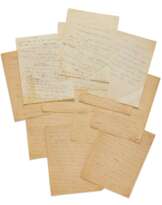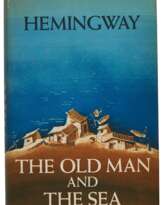ID 1105468
Lot 21 | Hemingway, Ernest | Autograph letter signed to John Herrmann, giving advice on writing
Valeur estimée
$ 10 000 – 15 000
Autograph letter signed ("Hem"), to John Herrmann at Erwinna, Pennsylvania, giving advice on writing
3 pages (252 x 205 mm) on 2 leaves of machine-laid paper, Piggott, Arkansas, 26 September [1928], accompanied by the original autograph envelope, signed on the verso ("Ernest Hemingway | Piggott, | Arkansas") and with Piggott postmark; envelope roughly opened and repaired with transparent tape affecting the E of Hemingway's signature.
"… action does not want to take place without taking place somewhere … "
A fine early letter in which Hemingway praises the literary efforts of John Herrmann and his wife Josephine Herbst, but still offers advice on writing, despite admitting that "nobody has any business telling anybody else anything." Hemingway had met the two fellow American writers in Paris in 1924 and the three became friends. Herrmann's first book, What Happens, was published in Paris by Contact Editions in 1927, although it was ruled obscene by U.S. district court and effectively banned in the United States. A month earlier Hemingway has wired a burb for Herbst's first book, Nothing Is Sacred ("nothing is sacred is a fine book it does not need blurbs it need readers stop Josephine her best is an honest writer and it is the honest writers who are great writers when all the so called 'great' writers are dead"; Letters 3:4290).
He begins this letter by asking about his cable—and reporting on a new book and new son of his own: "Hope Jo got the wire about her book— I had a hell of a time to get it to her in time as I was up in the mts. in Wyo working like a bastard [on A Farewell to Arms] and my mail was sent somewhere else by mistake—some I just got here yest— Had been forwarded five times— I finally got the galleys and wrote some bloody wire and sent it to Erwinna Pa. and also to a N.J. address she sent me hoping she would get one or the other. … Hope it came anyway and made some sense—dont know how much. Have the 1st draft of my book done now—also a new son named Pat—weights 16½ lbs. at 3 mos. …"
Hemingway then returns to Nothing Is Sacred and to Herrmann's coming-of-age novel. "How are you going? Hope Jo's book will go big—but no book goes big when you need it—only afterwards when you don't need it and it doesn't mean a damn thing—
"You are a hell of a good writer. Every once in a while I read your stuff again and it has only one faul—kick my ass if you want at this point—What Happens (with or without capitals) is always damned fine but you let it happen in a vacuum sometimes—you could just as easily make it happen somewhere, make the place as well as the people and and [sic] action— Then you would knock them all for a row of cesspools. Maybe I wrote you this before. I thought about it and meant to and if I did kick me again in the same place. You see what I mean—that action does not want to take place without taking place somewhere— You must make the place too— I don't mean just descriptions— Make it. You are a good writer and can make bums out of all of them if you will do that.
"Write me to Piggott if I wrote you this before and I'll stop. Will stop anyway—but I think about your stuff a lot and that is what I think. You are a better writer than Jo because you have more talent— (Don't for God's sake tell her this. She has talent enough God knows) [Hemingway underlines and double-underlines the preceding parenthetical] (But you could butcher them all.) You both are honest as hell and when see you doing this— (leaving out the place where it happens) I tell you as though you were a boxer who did not keep his jaw covered against a hook— But as I say kick me—nobody has any business telling anybody else anything— Maybe I wrote you this three times— Anyway good luck and so long and my best to Jo and every sort of luck to her— She knows how I liked her book from the wire I hope."
In a postscript, Hemingway adds, "We just got in last night— Have driven 9200 miles—not so bad for an old expatriate— Montana and Wyo are damned fine."
| Artiste: | Ernest Miller Hemingway (1899 - 1961) |
|---|---|
| Catégorie maison de vente aux enchères: | Impressions, graphiques, livres |
| Artiste: | Ernest Miller Hemingway (1899 - 1961) |
|---|---|
| Catégorie maison de vente aux enchères: | Impressions, graphiques, livres |
| Adresse de l'enchère |
Sotheby´s 1334 York Avenue 10021 New York Etats-Unis | ||||||||||||||
|---|---|---|---|---|---|---|---|---|---|---|---|---|---|---|---|
| Aperçu |
| ||||||||||||||
| Téléphone | +1 212 606 7000 | ||||||||||||||
| Conditions d'utilisation | Conditions d'utilisation | ||||||||||||||
| Heures d'ouverture | Heures d'ouverture
|















